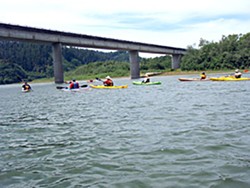[
{
"name": "Top Stories Video Pair",
"insertPoint": "7",
"component": "17087298",
"parentWrapperClass": "fdn-ads-inline-content-block",
"requiredCountToDisplay": "1"
}
]
When I'm kayaking the lower reaches of the Klamath, it sure feels like a one big river. Over 250 miles long, the Klamath drains an area of nearly 16,000 square miles, about four times that of Humboldt County. Yet it's puny compared to its big brother on the west coast, the Columbia, which is five times as long and drains an area 16 times as large. It is, however, the second-largest river in California (after the Sacramento), originating in southern Oregon and flowing into the Pacific at Requa, just north of the Humboldt county border.
A fish swimming 200 miles upstream from the Klamath's mouth would encounter a 173 ft. high concrete wall, aka Iron Gate dam, located about 20 miles northeast of Yreka and just south of the Oregon border. According to just about everyone except the owner-operator, Warren Buffett's PacifiCorp, the dam is largely responsible for the near-complete loss of the once abundant annual salmon and steelhead runs.
Last November, an "agreement in principle" to remove Iron Gate and three more hydroelectric dams farther upstream was announced between the federal government, the states of California and Oregon, and PacifiCorp. The agreement calls for a start to be made on decommissioning them by the year 2020, which, if good will and good deeds prevail, will be the largest dam removal project in U.S. history. My fingers are firmly (if somewhat skeptically) crossed.
In the period (between 50 and 100 years ago) when these hydroelectric dams were built, little thought was given to the environmental consequences. Even so, it's hard to imagine what planners were thinking in the early 1960s. That's when an 813 ft. high dam, named "Ah Pah," was proposed near the mouth of the river. It would have flooded not just nearly 100 miles of the Klamath, but 40 miles of the Trinity River, including the Hoopa reservation.
Fortunately, that one never made the light of day. Now all we've got to do is get rid of the ones that were built.
more from the author
-
Doubting Shakespeare, Part 2: Problems
- May 2, 2024
-
Doubting Shakespeare, Part 1: Stratfordians vs. anti-Stratfordians
- Apr 25, 2024
-
A Brief History of Dildos
- Apr 11, 2024
- More »
Latest in Field Notes
Readers also liked…
-
Trouble on the Line: The Reality Part 2
- Nov 3, 2022

































